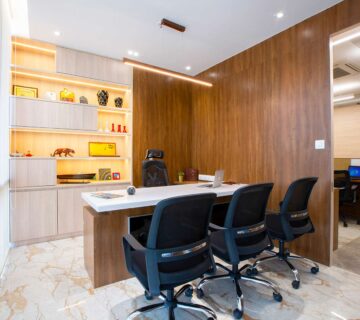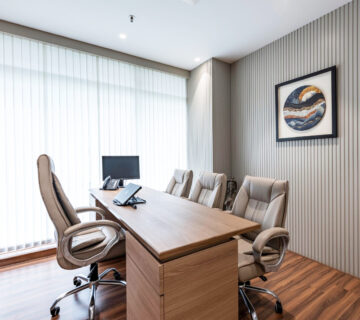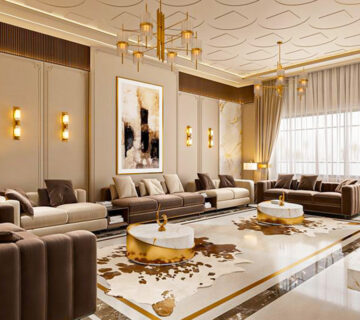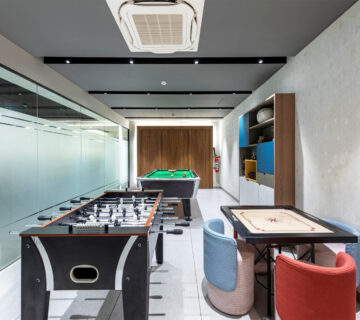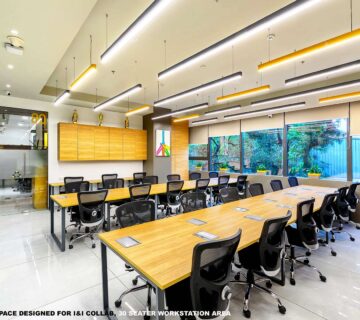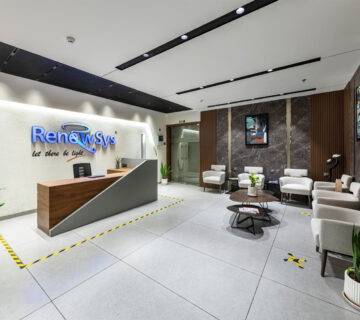Introduction
Planning a commercial interior design project on a budget can be difficult, especially when aesthetics, practicality, and pricing are all important considerations. Strategic planning guarantees that you can build a beautiful and functional space without going over budget, whether you’re remodelling an office, retail store, or restaurant.
We’ll walk you through a cost-effective approach to commercial interior design in this article, which will include budget planning, cost-cutting techniques, and typical blunders to avoid. By the end, you’ll have useful advice on how to create a stunning and useful space while staying within your means.
Understanding Commercial Interior Design
Creating aesthetically beautiful and useful spaces for businesses is the main goal of commercial interior design. Commercial spaces need to be carefully planned to match branding, customer experience, and operational effectiveness, unlike residential spaces. Well-designed interiors have an impact on consumer engagement, employee productivity, and overall business success, regardless of the setting—an office, retail store, or hospitality establishment.
Why Budgeting Is Crucial in Commercial Design
A well-planned budget prevents overspending and ensures financial resources are allocated efficiently. Budgeting in commercial interior design is essential because:
- It helps prioritize expenses, ensuring essential elements are covered first.
- Avoids unexpected costs and financial strain during the project.
- Ensures a balance between aesthetics and functionality without compromising quality.
- Maximizes ROI by investing in durable, high-quality materials and designs.
Steps to Plan a Commercial Interior Design Project Within Budget
1. Define Your Vision & Goals
Before starting the project, clearly define your objectives:
- What is the purpose of the space? (Office, retail, restaurant, etc.)
- Who will be using it? (Employees, customers, clients)
- What kind of ambiance do you want to create? (Modern, minimalist, industrial)
2. Set a Realistic Budget
Break down the costs into categories such as:
- Interior design consultation
- Furniture and fixtures
- Flooring and lighting
- Wall treatments and branding elements
- Labor and construction costs
Get quotes from multiple vendors and allocate funds accordingly.
3. Prioritize Key Elements
Identify must-have features versus nice-to-have ones. Focus on investments that offer long-term value, such as ergonomic office furniture, energy-efficient lighting, and durable flooring.
4. Hire the Right Interior Designer or Contractor
A professional designer with experience in commercial projects can help optimize the budget. Look for designers who:
- Understand your industry-specific needs
- Have a proven portfolio of cost-effective designs
- Offer creative solutions for budget constraints
5. Choose Cost-Effective Materials & Finishes
Instead of expensive materials, consider budget-friendly alternatives:
- Flooring: Luxury vinyl tiles (LVT) instead of hardwood
- Furniture: Refurbished or pre-owned office furniture
- Walls: Wallpaper or textured paint instead of expensive paneling
6. Optimize Space Planning
Efficient space planning enhances functionality while minimizing unnecessary costs.
- Open-plan layouts reduce the need for excessive partitions.
- Multi-functional furniture saves space and money.
- Smart storage solutions prevent clutter.
7. Leverage Smart Technology
Invest in budget-friendly smart solutions like:
- Energy-efficient LED lighting to cut electricity costs
- Smart thermostats for better climate control
- Motion-sensor lights to reduce wastage
8. Repurpose & Upcycle
Repurposing existing furniture and fixtures can save thousands. Consider:
- Refinishing wooden furniture instead of replacing it
- Reupholstering chairs for a fresh look
- DIY decor elements using cost-effective materials
9. Plan for Maintenance & Future Scalability
Choose designs that require low maintenance and allow for easy upgrades in the future. Modular furniture and adaptable layouts make expansion cost-effective.
Latest Trends & Cost-Saving Solutions
- Sustainable Design – Eco-friendly materials like bamboo flooring and recycled furniture reduce costs and environmental impact.
- Biophilic Elements – Incorporating plants and natural lighting enhances well-being without major expenses.
- Minimalist Aesthetics – A clutter-free, sleek look saves money on excessive decor.
- DIY Branding & Signage – Customized signage using cost-effective printing methods enhances brand identity at a lower cost.
Common Mistakes to Avoid
- Ignoring a Contingency Fund – Always keep 10-15% of your budget aside for unexpected expenses.
- Overlooking Functionality for Aesthetics – A beautiful space that lacks comfort and usability is a waste of investment.
- Choosing Cheap Over Quality – While budgeting is important, poor-quality materials may cost more in long-term repairs.
- Skipping Professional Help – DIY mistakes can lead to costly errors.
- Neglecting Lighting & Acoustics – Poor lighting and noise levels affect productivity and customer experience.
Pro Tips for Budget-Friendly Interior Design
- Shop Smart: Look for wholesale suppliers, clearance sales, and online discounts.
- Negotiate with Vendors: Many suppliers offer discounts on bulk purchases.
- Use Multi-Purpose Decor: Items like mirrors can enhance space visually while serving a functional purpose.
- Go Modular: Modular furniture allows easy reconfiguration as business needs change.
- Invest in Energy Efficiency: LED lighting and smart thermostats reduce operational costs.
Frequently Asked Questions (FAQs)
1. How much should I budget for a commercial interior design project?
It depends on the size, complexity, and materials used. A small office may cost ₹5-10 lakh, while larger projects may go beyond ₹50 lakh.
2. Can I do commercial interior design on a small budget?
Yes! With smart planning, cost-effective materials, and DIY elements, you can create a professional space without overspending.
3. Should I hire an interior designer or do it myself?
Hiring a designer ensures better space utilization and cost efficiency. However, if you have a keen eye for design, you can manage small projects independently.
4. What are the best cost-saving strategies?
- Repurpose existing furniture
- Use affordable alternatives for expensive materials
- Buy second-hand items in good condition
- Plan ahead to avoid last-minute expenses
5. How do I make my commercial space look luxurious on a budget?
Focus on lighting, minimal yet elegant decor, and high-impact features like statement walls or unique textures.
Conclusion
Creating a stunning commercial space within budget is all about smart planning, prioritization, and cost-effective choices. By defining clear goals, selecting budget-friendly materials, and optimizing space efficiently, you can achieve a professional and functional design without overspending. Avoid common mistakes, invest in quality where it matters, and leverage cost-saving strategies like repurposing furniture and using energy-efficient solutions.
A well-designed space not only enhances aesthetics but also boosts productivity and customer experience. Need expert guidance? Contact us today for a free consultation and let’s bring your vision to life—without breaking the bank! 🚀


